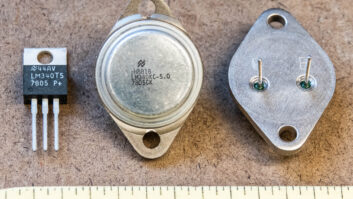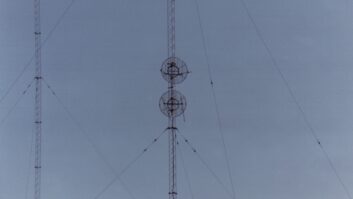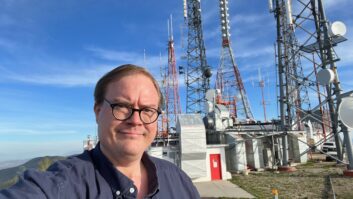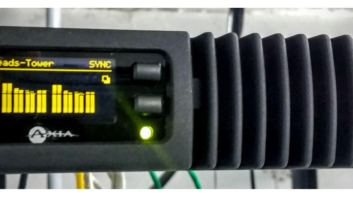Digital STLs
Aug 1, 2001 12:00 PM, By Dave Agnew, CSRE
Until the last few years, the narrow bandwidth (300kHz) of the 950MHz radio channels, which was adequate for the audio and technical standards of the all-analog world, was insufficient to handle the much greater bandwidth of the digital signals of newer generation, AES3-compliant studio equipment. If stations wanted to use 950MHz radio channels for their studio-to-transmitter link, they had to compress their high-bandwidth digital audio to fit the limited bandwidth of the STL.
Figure 1. On-off keying (OOK/s-ASK).

Figure 2. Binary phase shift keying (BPSK).

Neither of the two types of data compression schemes lossless and lossy was very practical, however. While lossless data compression does not degrade the quality of the received data in theory, current lossless compression technologies used on personal computers are simply not effective in reducing audio data in practice. Lossy-type data compression schemes, which take advantage of perceptual masking to discard some of the audio without being very noticeable to the listener, can provide satisfactory results when used properly. However, when a signal is compressed two or more times for example, for music storage and to convey audio from the studio to the transmitter listeners begin to notice reduced audio quality.
It was only with the introduction of 950MHz, frequency agile, digital STLs, which use true digital modulation techniques to transport uncompressed AES3 digital audio, that it was possible for broadcasters to implement a digital studio-to-transmitter link without the previously required use of lossy data compression. This new approach prevents the possibility of cascading compression algorithms within the STL link, which can cause audible artifacts in the recovered signal.
Several digital modulation techniques are in use today, each with its own set of advantages and disadvantages. Some methods are very robust but require large amounts of bandwidth. Others are more spectrally efficient but can be more prone to errors, requiring more sophisticated forms of error correction. The goal of all of these techniques is to transport unimpaired digital 1s and 0s from point A to point B.
Digital modulation
The amplitude and the phase of a high frequency carrier can be represented using a phasor or vector diagram. The I (In-Phase) axis of the phasor represents the in-phase component and its amplitude, and the Q (Quadrature) axis represents a 90 degree phase shift from the reference axis I. With this diagram, it is possible to represent a carrier at different points of amplitude, phase or combinations of the two. These points on the phasor are referred to as constellation points.
One of the most basic forms of digital modulation is called Amplitude Shift Keying (ASK). In amplitude shift keying, the carrier has two possible states, On and Off, On representing a digital 1, and Off representing a digital 0. One bit of digital data may be transmitted using ASK. Figure 1 shows ASK using the phasor diagram.
Bi-Phase Shift Keying (BPSK) allows the transmission of one bit of digital information in both states 0 and 1 by shifting the phase of the carrier from 0� (reference) to 180�. Figure 2 shows BPSK. The 0� reference represents a digital 1 and the 180� position represents a digital 0.
Figure 3. Quadrature phase shift keying (QPSK).

Quadrature Phase Shift Keying (QPSK) allows the transmission of 2 bits of data within the same occupied bandwidth as BPSK. QPSK uses four phase positions, 45�, 135�, 225�, and 315�, to represent a 0 or 1 for two bits of digital data. Figure 3 graphically represents QPSK. The individual phase positions represent the value of the digital word as in BPSK. BPSK and QPSK vary the phase of the carrier to represent more digital data bits.
A third method, Quadrature Amplitude Modulation (QAM), varies both the phase and amplitude of a carrier to represent more symbol points and thus more bits of digital data within the same occupied bandwidth. Typical QAM formats are 16QAM, 32QAM and 64QAM, allowing the transmission of 4-, 5- and 6-bit digital words, respectively. The advantage of QAM over BPSK and QPSK is that more data may be transmitted within the same RF bandwidth. The disadvantage of higher rate QAM formats is that the signal becomes more delicate and prone to errors as the number of symbol points increases. As the QAM rate increases, from 16 to 64, more sophisticated modulation detection circuitry and the addition of different forms of error correction are required in order to keep the Bit-Error-Rate (BER) low. Figure 4 is a graphic representation of 16QAM.
Digital RF STL systems today use various QAM rates and different bandwidths (depending on the type of modulation and number of channels of linear audio) to modulate a combination of main channel audio, auxiliary audio and RS232 data subcarriers onto the RF carrier. Different manufacturers offer different solutions. The various transmitter input signals are combined into a baseband signal and then coded using different forms of error correction algorithms. The final PA in the STL amplifies the small signal output of the modulator. The power amplifier typically employs linearization techniques that correct for channel impairments and nonlinearities in the power amplifier, in order to meet the channel RF mask requirements.
Figure 4. 16QAM.

With two watts of average power output and a receiver signal threshold of -90dB (7mV), it is possible to operate with paths up to 50 miles using 8-foot parabolic dishes and still maintain an adequate fade margin of about 40dB.
The receiver demodulates the RF carrier back to the coded baseband signal. The encoded data stream is then applied to an inverse coding algorithm, which rearranges the data back into its original order, correcting errors incurred along the way. Most receivers will simultaneously output AES3 digital audio, optical AES3 audio, analog left and right audio signals, data channels and other various optional outputs.
There are many advantages to using an uncompressed all-digital path from your studio to your transmitter, including the elimination of all A/D and D/A conversions, which add distortion, noise and system costs as well as full digital quality delivered to the on-air signal. Recent technological advancements make all of this possible using standard, off-the-shelf products.
Dave Agnew is a senior FM applications engineer at Harris Corporation Broadcast Communications Division, Cincinnati.












